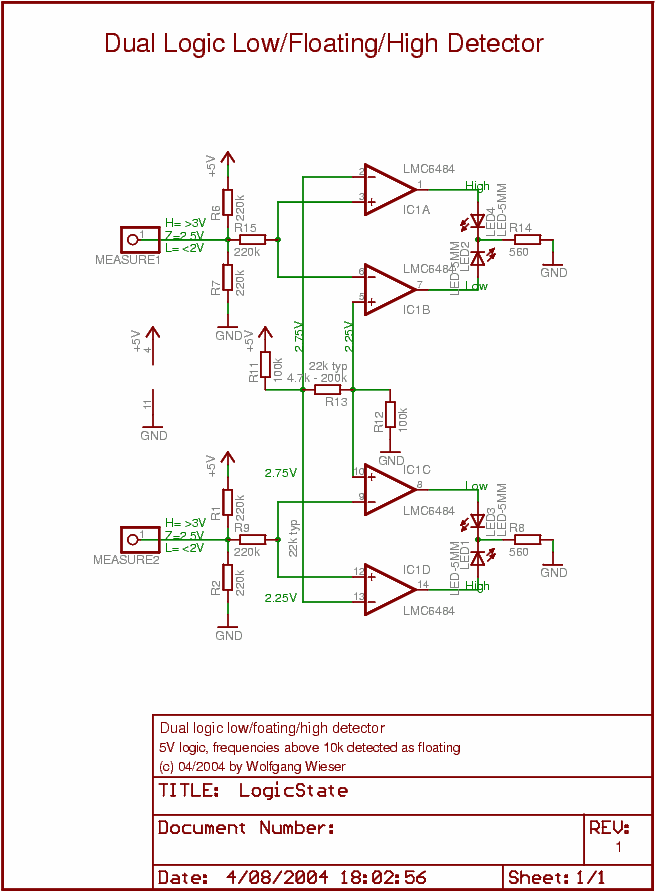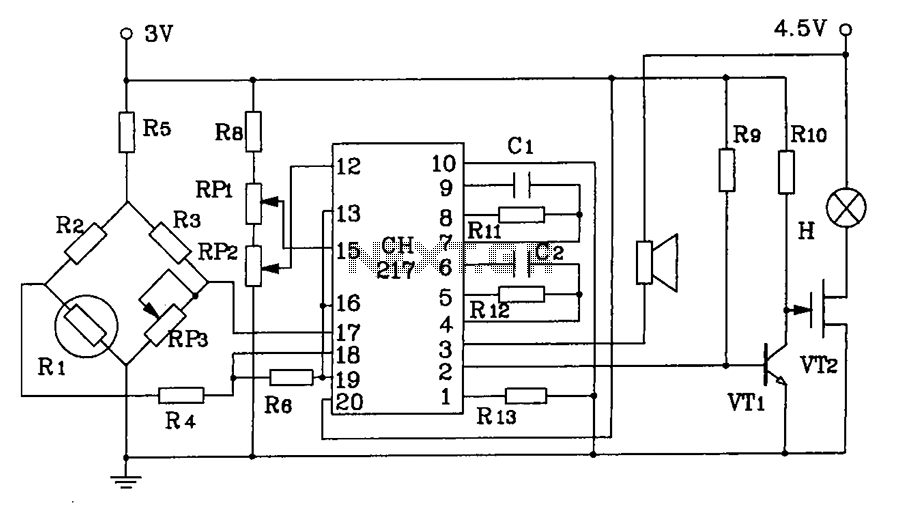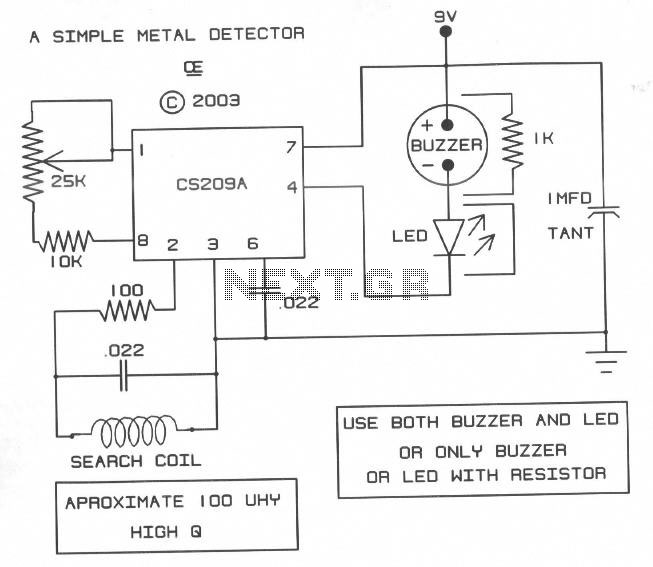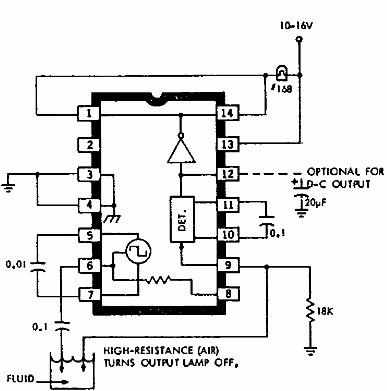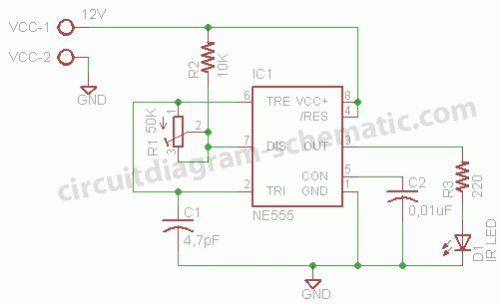
PIC16F84A Gas Detector
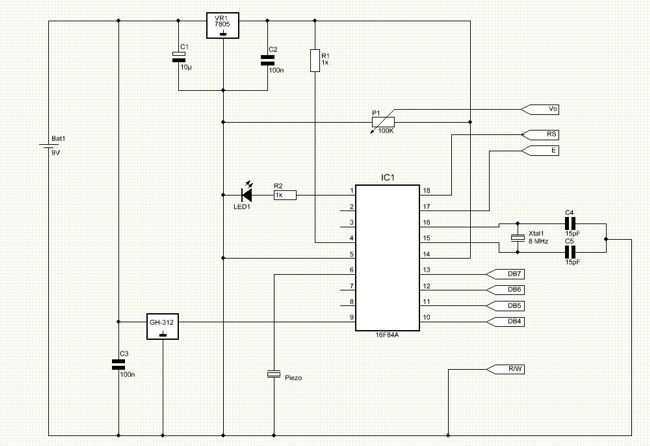
This is a gas detecting circuit capable of sensing many different types of gases. The sensor used is the GH-312 and from the datasheet it is capable of sensing gases like smoke, liquefied gas, butane and propane, methane, alcohol, hydrogen, etc. A 9V battery is used for this project because the sensor requires a 9V input. The output when the sensor is triggered is always 5V, which is perfect for a direct connection to any microcontroller. Although a 9V battery is used, any 12V power supply (a small wall transformer for example) will work perfectly since the sensor can handle from 9V up to 20V, and the microcontroller's voltage is regulated by a 7805 regulator. It's a pretty cheap and easy to assemble circuit. To test the sensor, a portable gas soldering iron with the gas coming out pointed to the sensor was used.
The sensor is able to detect the gas, and the microcontroller will trigger a flashing LED warning and sound. The sound is produced by a small piezo, and the display shows the message "Found Gas." This circuit does not require too many parts, and the microcontroller is very easy to find (the famous 16F84A from Microchip). When the air is clean again and the sensor does not sense any gas, the circuit will return to its normal state, turning off both the LED and piezo sound. Since a small LCD (8x2) is used, this project can be portable. Also, this sensor senses several types of gas and is pretty stable.
The gas detection circuit primarily consists of the GH-312 gas sensor, which is sensitive to various combustible gases. The sensor operates on a voltage range of 9V to 20V, making it versatile for different power supply options. The output signal from the sensor is a digital high (5V) when gas is detected, which can be interfaced directly with a microcontroller such as the Microchip PIC16F84A.
The microcontroller is programmed to monitor the sensor's output continuously. Upon detecting gas, it activates an LED indicator to provide a visual warning and triggers a piezo buzzer to emit an audible alarm. The circuit can also incorporate an 8x2 LCD display that shows a warning message, such as "Found Gas," enhancing user awareness of the gas detection status.
Power regulation within the circuit is managed by a 7805 voltage regulator, ensuring that the microcontroller operates at a stable 5V, regardless of variations in the input voltage. The design is compact and can be assembled on a breadboard or a custom PCB, with minimal components required, making it cost-effective and easy to construct.
The circuit's portability is an essential feature, allowing it to be used in various settings, such as homes, laboratories, or industrial environments, where gas leaks might pose a risk. The stability of the GH-312 sensor ensures reliable performance across different gas types, providing a comprehensive solution for gas detection applications.This is a gas detecting circuit capable of sensing many different types of gases. The sensor used is the GH-312 and from the datasheet it is capable of sensing gases like smoke, liquefied gas, butane and propane, Methane, alcohol, hydrogen, etc. I've used a 9V battery for this project because the sensor requires a 9V input. The output when the sensor is triggered is always 5V which is perfect for a direct connection to any microcontroller.
Although I've used a 9V battery, any 12V power supply ( a small wall transformer for example ) will work perfectly since the sensor can handle from 9V up to 20V and the microcontroller's voltage is regulated by a 7805 regulator. It's a pretty cheap and easy to assemble circuit. To test the sensor I used my portable gas soldering iron with the gas coming out pointed to the sensor. The sensor is able to detect the gas and the microcontroller will trigger a flashing led warning and sound.
The sound is produced by a small piezo and the display show the message "Found Gas". Does not require too many parts and the microcontroller is very easy to find ( the famous 16F84A from microchip ). When the air is clean again and the sensor does not sense any gas, the circuit will return to it's normal state turning off both led and piezo sound.
Since it's used a small lcd ( 8x2 ) this project can be portable. Also this sensor senses several types of gas and it's pretty stable. 🔗 External reference
The sensor is able to detect the gas, and the microcontroller will trigger a flashing LED warning and sound. The sound is produced by a small piezo, and the display shows the message "Found Gas." This circuit does not require too many parts, and the microcontroller is very easy to find (the famous 16F84A from Microchip). When the air is clean again and the sensor does not sense any gas, the circuit will return to its normal state, turning off both the LED and piezo sound. Since a small LCD (8x2) is used, this project can be portable. Also, this sensor senses several types of gas and is pretty stable.
The gas detection circuit primarily consists of the GH-312 gas sensor, which is sensitive to various combustible gases. The sensor operates on a voltage range of 9V to 20V, making it versatile for different power supply options. The output signal from the sensor is a digital high (5V) when gas is detected, which can be interfaced directly with a microcontroller such as the Microchip PIC16F84A.
The microcontroller is programmed to monitor the sensor's output continuously. Upon detecting gas, it activates an LED indicator to provide a visual warning and triggers a piezo buzzer to emit an audible alarm. The circuit can also incorporate an 8x2 LCD display that shows a warning message, such as "Found Gas," enhancing user awareness of the gas detection status.
Power regulation within the circuit is managed by a 7805 voltage regulator, ensuring that the microcontroller operates at a stable 5V, regardless of variations in the input voltage. The design is compact and can be assembled on a breadboard or a custom PCB, with minimal components required, making it cost-effective and easy to construct.
The circuit's portability is an essential feature, allowing it to be used in various settings, such as homes, laboratories, or industrial environments, where gas leaks might pose a risk. The stability of the GH-312 sensor ensures reliable performance across different gas types, providing a comprehensive solution for gas detection applications.This is a gas detecting circuit capable of sensing many different types of gases. The sensor used is the GH-312 and from the datasheet it is capable of sensing gases like smoke, liquefied gas, butane and propane, Methane, alcohol, hydrogen, etc. I've used a 9V battery for this project because the sensor requires a 9V input. The output when the sensor is triggered is always 5V which is perfect for a direct connection to any microcontroller.
Although I've used a 9V battery, any 12V power supply ( a small wall transformer for example ) will work perfectly since the sensor can handle from 9V up to 20V and the microcontroller's voltage is regulated by a 7805 regulator. It's a pretty cheap and easy to assemble circuit. To test the sensor I used my portable gas soldering iron with the gas coming out pointed to the sensor. The sensor is able to detect the gas and the microcontroller will trigger a flashing led warning and sound.
The sound is produced by a small piezo and the display show the message "Found Gas". Does not require too many parts and the microcontroller is very easy to find ( the famous 16F84A from microchip ). When the air is clean again and the sensor does not sense any gas, the circuit will return to it's normal state turning off both led and piezo sound.
Since it's used a small lcd ( 8x2 ) this project can be portable. Also this sensor senses several types of gas and it's pretty stable. 🔗 External reference
